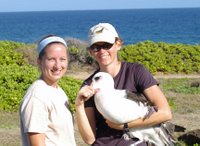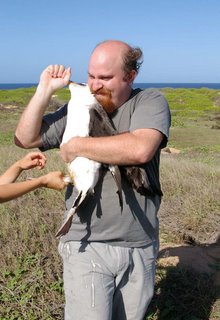One of the other grad students in the lab, Lindsay, is doing her dissertation work on the Laysan Albatross, and offered to show the rest of us her field site at Kaena Point. For those of you who aren't familiar with it, Kaena Point is the northwestern tip of Oahu. A fair amount of the tip of the island is a nature preserve, with good reason. A number of seabirds have breeding colonies there, Hawaiian monk seals are frequently seen on the beaches in the area, and there is a great deal of native vegetation. Oahu's environment has been massively disturbed by humans, and Kaena Point is one of the few natural areas left that hasn't been entirely ruined by human contact.
Lindsay is keeping tabs on this particular colony, checking on the progress of nests and eggs, figuring out which birds are mates, and who is responsible for which nest, and other such things. The rest of us were there partly to assist her and partly to sightsee.
 This group of birds are the unmated crowd. They haven't yet been able to successfully mate, and are just hanging around the edges on the colony. Most of these had run across Lindsey before, and had the leg bands to show for it. Another couple did not, but took off before we got close to them. One wasn't so lucky, and got grabbed.
This group of birds are the unmated crowd. They haven't yet been able to successfully mate, and are just hanging around the edges on the colony. Most of these had run across Lindsey before, and had the leg bands to show for it. Another couple did not, but took off before we got close to them. One wasn't so lucky, and got grabbed.  Kim's holding the bird for Lindsay, who is taking a blood sample. Nori is all set to apply pressure to stop the bleeding. The blood sample will be used for genetic work later on. (It's so much more fun doing the population genetics for a real population than it is working on things that only live in the lab.)
Kim's holding the bird for Lindsay, who is taking a blood sample. Nori is all set to apply pressure to stop the bleeding. The blood sample will be used for genetic work later on. (It's so much more fun doing the population genetics for a real population than it is working on things that only live in the lab.) Lindsay and Kim take a second to pose for a picture with the bird. The bird is now wearing a pair of leg bands, and has donated a small amount of blood to further scientific advancement. Everyone looks so nice and calm. Even the bird almost looks content in this picture. It looked so nice and easy I figured I could give it a shot the next time. As it turns out, I was mistaken.
Lindsay and Kim take a second to pose for a picture with the bird. The bird is now wearing a pair of leg bands, and has donated a small amount of blood to further scientific advancement. Everyone looks so nice and calm. Even the bird almost looks content in this picture. It looked so nice and easy I figured I could give it a shot the next time. As it turns out, I was mistaken.
Yes, that is birdshit on my pants. A couple of minutes after that shot was taken, the bird managed to wiggle its beak free and take a couple of nips out of me. Lindsay got her blood sample, but I think the bird got more of mine.
By the time we got back to the parking lot, I was hot, tired, and sweaty. I had mud and birdcrap all over my clothes. I had a bit of sunburn on my face, except for a couple of little patches where the band-aids covered up some bird bites. I had scratches on my arms from albatross claws and from thorns. And I was totally and completely happy.
It wasn't just because we had seen monk seals and humpback whales, either. The charismatic megafauna are fun to look at, and it's nice to get some pictures of them, but the real joy comes from something else.
I'm not sure how to describe it, either. I think the closest I can come is that it's the joy of the active persuit of knowledge. It's what Feynman called the "kick in the discovery" and "the pleasure in finding the thing out." It's knowing that even if this isn't your project, your research, you are still part of something more than just a walk on the beach. It's wondering what makes things tick, and how this little piece fits into the puzzle of reality. It's the knowledge that no matter how much gets figured out this time, there will always be something else to learn later on. It's the childlike delight in poking at something just to find out what happens if you do. Being a part of the neverending story of science is just plain fun, and words alone simply can't do it justice.

No comments:
Post a Comment